Many of you are learning for the first time or adjusting to the new changes to the three-man mechanics. The shift from two-man to three-man can be challenging, even for experienced officials if you do not work three-man games regularly. This post was written to help you master the mechanics. Remember, a three-man game is really a two-man game with help.
Check out this new presentation on three man mechanics and read the primer that follows.
Pre-Game Conference
To start, make sure you do a thorough pregame with your crew. The GLOA three man pre-game is available on the Resources page. It is essential that you do a lengthy pre-game conference to walk through all of the mechanics before your game.
You CANNOT show up and run out on the field and expect to be successful. You will screw up. A solid pre-game will minimize those mistakes, but it will not eliminate them. Get yourself in the right mindset before the game, review and prepare. Once you are on the field, I suggest that you talk to yourself and remind yourself of your primary keys and where you need to go next.
Pre-Game Responsibilities
What a crew needs to do before a game is the same: coaches certification, check the fie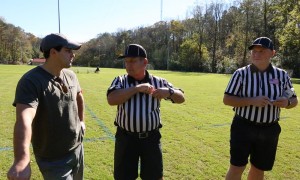 ld and goals, coin toss etc. There are a few minor differences. The Referee handles the coin toss, the Umpire take the Home Team captains out.
ld and goals, coin toss etc. There are a few minor differences. The Referee handles the coin toss, the Umpire take the Home Team captains out.
The Field Judge is responsible for the Visiting Team. The FJ should wait on the wing line for the U to move out first. The U and FJ escort the captains out to Center X and introduce them to the R. They then stand away from the R while the coin toss is conducted. Check to see which side the R will stand on.
The U and FJ check each teams goals prior to the lineup. do not assume the line up will go smoothly. Find out where the R prefers to be, get to the opposite side as U and FJ. Assume the players don’t know which side they should line up and assist them.
Counts
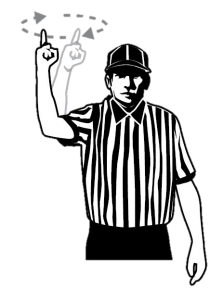
The Single works the far sideline serves as both a secondary Lead and Trail and has BOTH the twenty and ten counts. This means that all officials MUST communicate on when a new count begins and ends!
“Reset!”
When a change of possession happens, raise your hand and twirls your fingers. If you are not sure if the Single will see your signal you can verbalize “reset!” Should the riding team regain possession during a clear, this mechanic indicate that the clearing count has ended and a may indicate that a new ten count has begun. In hectic play, it can be difficult to keep track of what count is in place. Good communication is key.
The official with the best view of the player in possession or a loose ball entering the attack box MUST signal to his partner by raising one hand above their head, and then point down into the box. Hold your signal to be sure he sees it! Don’t be afraid to use your voice! Yell “He’s in!” to let your partner know a player has made the attack box and ended a count or “Reset!” to let him know a new count has begun. Remember, on a change of possession, a new count begins.
Positioning
The huge advantage of working a three-man game (Referee, Umpire and Field Judge) is the ability to maintain a wide triangle in transition and to have two men covering the crease in settled play. In addition to the Lead and Trail, we now have the Single side official. Both the Lead and the Trail are on the bench-side.
Lead
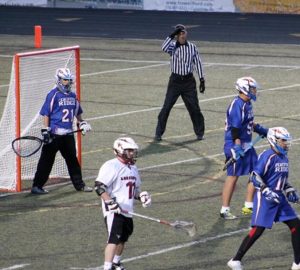 As in a two-man game, the Lead’s primary responsibilities are the goal and the endline. He should set up on, or just below, Goal Line Extended (GLE).
As in a two-man game, the Lead’s primary responsibilities are the goal and the endline. He should set up on, or just below, Goal Line Extended (GLE).
He should stay as close to the crease as play allows, working in the area inside the box to the hash marks on a football field, moving in and out with the flow of the players and passing lanes. The best place to be is a yard or two above or below GLE on the hash marks or at the edge of the girls shooting arc.
There is no need to remain exclusively on GLE; the Lead may move in and out along GLE or at a 45° angle towards the corner of the box and the endline. THis does not mean go to the endline or the corner of the box, but rather momentarily step out of the way of players or passes and then quickly return to your spot. This gives the official a good view of the crease and goal line and allows them to remain out of the way. Do not let players get behind you! And remember, unlike the two man game, you have help from the Single.
The Lead is the only official responsible for the endline. If there is a shot that misses the cage or any contested play behind the goal, the Lead MUST get down there to officiate the play and give up crease responsibility to the Single. Do not remain on the GLE with play happening below you.
In transition, the Lead has the sideline on the bench side until the Trail is in position to assume that responsibility.
Single Side: Secondary Lead/Secondary Trail
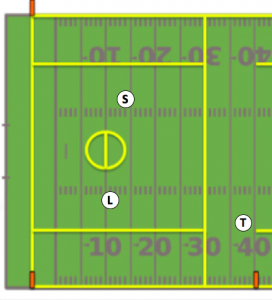
The Single has shifting responsibilities and serves as a hybrid of the Lead and the Trail.
In settled situations, the single sets up NO MORE THAN three to five yards above GLE on the far side. The best place to be is a three to five yards above or below GLE on the hash marks or at the edge of the girls shooting arc.
Many officials are setting up on the 10 or 20 or 25 yard lines as well as not moving in and out with the play. This is incorrect positioning.
Like the Lead, he moves in and out towards the crease as play allows, moving in and out with the flow of the players and passing lanes. His primary responsibility is in the area in front of the crease.
The Single works in tandem with the Lead and serves as a secondary Lead when the Lead can not cover the goal. If the Lead has the goal, the Single has the scrimmage area in front of the goal and must be watching the shooter or feeder looking for late hits, moving picks and crease violations. He will signal a goal if he has the goal responsibility because the Lead has been pushed out or it is clear the Lead was screened. He should move in quickly and focus on the area in front of the crease for violations.
If the Lead is in the corner or at the end line, Single assumes his goal and crease responsibilities. The Single should NEVER drop below GLE.
Trail
In the settled situations, the Trail serves as the clean up guy and crew saver! The Trail watches the shooter! Like I said, a three man game is really a two-man game with help. The Trail is that help. When he is not on ball, he should watch the crease area, especially one on one midfield play, and any late hits or cheap hits on passes or shots.
Remember the primary responsibility of the Trail is the Goal BEHIND him. It is perfectly acceptable for a Trail to set up deeper than he would in a two-man game; roughly at the bottom of the wing line on the 40 yard line. There is NO need for a Trail to creep forward. It is imperative that he anticipate transition. On a shot or drive to the crease, the Trail should begin moving backwards in the event of a turnover or save.
As the Trail is closest to the benches, he plays a key role in communicating with the tables and benches. It is important to be aware of the situation as the Trail will most likely call any Time Outs. The Trail also relays all penalties to the table.
The Trail also manages the substitution area. He must stay alert for the time-out call! So be aware of where you are in the game e.g. close games in the fourth quarter or in overtime!
Crease Play
One of the most difficult plays to officiate even in a three-man game, is the bang- bang play right on the crease. Remember that a player must be grounded before during and after the shot for a goal to count if they land (legally or as a result of illegal contact).
The Lead and the Single need to work together to properly officiate the play. BOTH officials should crash to the crease– you can avoi d players in front of you by cutting under the play.
The official who is looking at the back of the player has the push call. The official who is watching the front of the player has the feet and the goal. If the player scores before entering the crease, signal goal, if not COME IN HARD blowing your whistle and signal a crease violation or waiving off the goal. Look to your partner to be sure you are both on the same page. DO NOT signal goal unless you are standing in the crease.
If there is a push THROW YOUR FLAG! Even though the foul may well be wiped out by a goal, it is imperative that you let the coaches and players know that you saw the foul!
Goal Scored: The Exchange & Rotation
The Lead will signal the goal and take the ball from the goalie and heads to the faceoff x and conduct the faceoff as the new Single side official. The old Single moves to the bench side and will be either the Lead Left or the Lead Right.
On and Off Officials
 In a two man game it is fairly black and white who has the ball and who does not. This can get a bit more complicated in a three man game. If the ball is in the Lead’s area, the Single official takes the crease. When the ball moves into the Single’s area, the responsibilities reverse themselves.
In a two man game it is fairly black and white who has the ball and who does not. This can get a bit more complicated in a three man game. If the ball is in the Lead’s area, the Single official takes the crease. When the ball moves into the Single’s area, the responsibilities reverse themselves.
There will however be overlap. If the ball falls into the “gray area” between officials, a good rule of thumb is if the ball carrier is facing your direction, you have responsibility for the ball. Your partners should look off the ball to the crease area.
Often the Trail will be slow to get into the play as he works his way up the field. The Trail most often shares being the On Official with the Lead and the Single. Remember, often one officials angle and positioning allow him to see a foul. See the foul, make the call!
With three officials on the field the same principles apply: we do not need 6 eyes following the ball. Watch the rest of the field.
Transition
The most important rule of thumb: the new Lead should ALWAYS beat the ball to the Goal and End Line!
At the change of possession, Single initiates his 20-second count and breaks out and straddles the midfield line at the far cone. The Single should remain at the cone until the ball has passed him, DO NOT get ahead of the ball. Single has primary offside responsibility. Remember to COUNT FORWARDS! Single also has the ten second counts once the ball crosses midfield and is possessed. In the event of an obvious fast break, he can break immediately to the top of the box (two-man trail position) in order to keep a wide angle on the play and then your settled into position five yards above GLE as the new Trail makes his way into your half of the field.
Trail is responsible for the 4-second count on the goalie and is watching for crease violations and goalkeeper interference. He is primarily responsible for all fouls occurring in the defensive zone. He should stay even or slightly behind the ball as his primary responsibility is still his goal. The Trail should NEVER follow the flight of a long pass, instead he should remain focused on the defender and the offensive player.
Once the ball is cleared, the trail moves up to bottom of the wing line and monitors all contested substitutions. Be sure to look across at the Single. The Trail should NEVER pass the Single; be sure to hold your position until the Single has released off the cone and moves into the box.
Once the Trail is in position in a settled situation, be sure to let the Lead know that you know have the sideline covered.
Over & Back
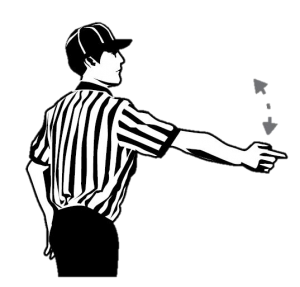 The Trail has any over and back violation. If there is a potential for an over an back violation the Lead and Single must let the Trail know if the ball is tipped or it is a shot. Communication is key.
The Trail has any over and back violation. If there is a potential for an over an back violation the Lead and Single must let the Trail know if the ball is tipped or it is a shot. Communication is key.
The Single MUST get to the midline to help the Trail in these situations. If a violation is called, the Single should take the restart and allow the Trail, now new Lead, to get into position.
Faceoff
The Lead Right sets up on the wing line holds hand up, pumps and and initiates the 20-second timer, all the while keeping his eyes on the entire field. He then quickly writes the score down. Once the field is ready for play, they point to the goal they are responsible for. He is responsible for all four wing players. If two wing players are set up far apart from one another, they are unlikely to cause any problems. Focus on the players that lined up next to each other.
Lead left serves as the helper to the faceoff official. His job is to check the neutral zone, make sure both players sticks are off the midline.
The Lead Left NEVER adjusts crosses. You do not want to headbut the faceoff offical! Once he has made sure the players are in the proper positions, he can back out to a spot he is comfortable getting to his goal in the event of a fast break his direction. He should remain motionless during the faceoff so as not to distract the players. As the whistle is blown to begin the faceoff, the helper should watch for players moving early and the initial move of the faceoff men.
As the FO official you will back out to the FAR SIDE. You are the only official who can make a call if the ball goes out of bounds on the far sideline. Do not stop and watch the faceoff, continue to back out and to put yourself in a position to be successful.
Dead Ball Officiating
In a three man game communication is paramount. This is especially true during dead ball situations.
Setting the Field for Man Up
Following a penalty, be sure to relay the penalty to your partners, the Trail then relays the foul to the table. While he does so, the other two officials should set the field. This means you need to find the ball, let the keeper know where the ball will be restarted and for how long his team is man down. Check to be sure that each team has the correct number of players. NEVER ASSUME ANYTHING. When the Trail turns around, the field should be ready to go!
Similarly, on time outs and after a quarter has ended, make sure you know where the ball is, where it will start and where everyone will be positioned.
Timeouts
Watch the teams cross. Eyes should always be on mixed colors in close proximity. Remind assistant coaches how many time outs they have remaining. The head coach has enough on his plate. DO NOT write on your card or do anything else until everyone is in their own huddle.
Equipment Check
Mandated random equipment checks will be done at time outs or at the end of the first and third periods. The bench side officials will select a player from each team and check for legal helmet, stick, gloves, shoulder pads, arm pads, mouthpiece and cleats.
They will take a stick out to the Center X to be measured by the Referee.The Single will secure a ball and meet the other officials at the X. Lead and Trail should grab a stick from the team whose bench they are in front of. The Field Judge and Umpire are positioned on either side of the midline facing the benches.The Referee, with his back to the benches, will measure the sticks, which are held out in front of the Field Judge and Umpire.
I hope this helps! Please let me know if you have any questions and good luck this season.
Best,
Greg Hite
GLOA Trainer
